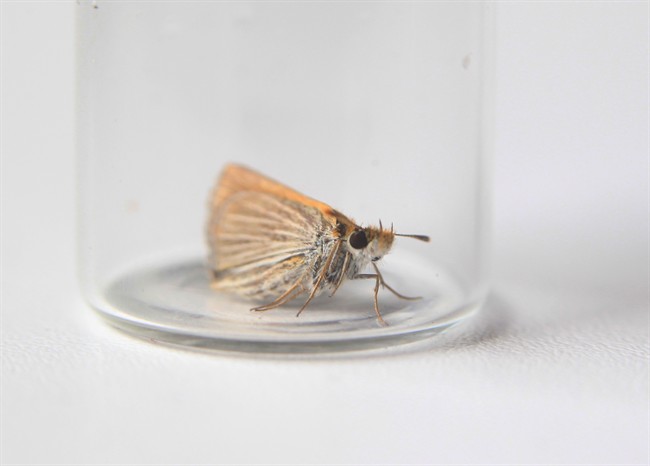Years of work came to fruition on Friday when the Assiniboine Park Conservancy announced their annual release of a critically endangered species of butterfly back to their natural habitat in an effort to restore both the population and the habitat it lives in.

Nearly five dozen Poweshiek skipperlings were set free at the Tall Grass Prairie Preserve near Vita, Man. — the only place left in Canada they can be found.
Elsewhere, the dime-sized brown butterfly’s only other natural habitat is in Flint, Mich., and at the Assiniboine Park Conservancy where they are being bred and released.
“In the early 2000s we used to see them across the Midwest and in Canada and in the course of about 10 years we lost over 90 per cent of the populations that exist,” said Laura Burns, a research and conservation specialist with the zoo.
With about 500 Poweshieks left in the wild, the decline in the pollinator’s population remains a mystery, be it pesticides, climate change or invasive species.
But despite the cause, Burns is now focused on repopulating the species at the preserve.
“Our job right now is making sure they don’t go extinct while we find out what happened,” she said.
In the program’s sixth year of breeding and releasing, the team released the Poweshieks to a new area of the Tall Grass Prairie Preserve, an area in southeast Manitoba that is now considered one of the most endangered ecosystems in the world. Only about one per cent of the habitat remains from what there once was.
Much like the canary in the coal mine, the Powshiek skipperling, and its sister species the Dakota skipperling which are also being bred for repopulation at the zoo, are what conservationists call “indicator species.”
“When you lose a butterfly or the populations crash it’s telling you the habitat isn’t healthy anymore,” Burns said.
“And that’s what the Poweshiek and Dakota skipper are telling us — that we need to make the prairie more healthy.”
Unlike their black and orange counterparts the Monarch butterfly, which gravitate toward milkweed and can travel long distances, skipperlings are homebodies and the environment they live in can’t be emulated in a residential backyard. Restoring the Tall Grass Prairie is the only option to keep the insect from going extinct.
Marika Olynyk, a stewardship coordinator for the Nature Conservancy of Canada, works with the zoo to manage the preserve and ensure skipperlings have a chance at survival when they’re released into the habitat.
Controlled burns, mowing back shrubs and plants which can encroach on the preserve and managing invasive species are all done to help skipperlings thrive in the habitat.
“It’s actually really exciting when you think about it, there’s less than 500 left and we’re starting to reintroduce them to their former habitats,” she said.
The conservancy and zoo also frequently monitor the southeastern preserve to see if numbers are holding up or declining. This year, Burns said they’ve seen more skipperlings than ever before.
“Right now I’m really optimistic,” the researcher said.
Burns said the more releases they do, the more hopeful she is the human population will become enamored with the insect population and advocate for their survival.
“Tiny, small things matter and everybody loves an underdog story … I can’t think of a better underdog than a tiny, brown butterfly that most people have never seen.”









Comments